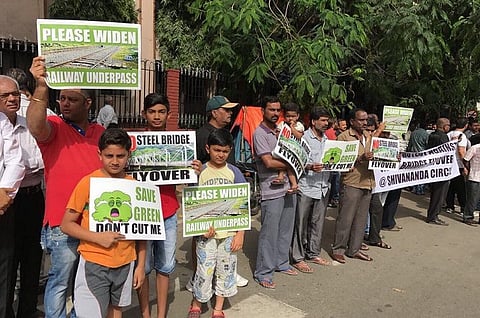

Just months after the Hebbal steel flyover was scrapped in a major victory for the citizens’ movement that rose up against it, the battle over another steel flyover is building.
Ever since it was announced in June, the flyover proposed at Shivananda Circle has drawn strong opposition from residents of the area. The proposed bridge will be 326 metres long and will connect Race Course Road to Hare Krishna Road, and the railway underpass in Sheshadripuram, at an estimated cost of Rs 50 crore.
In July, a group of residents petitioned the High Court against the flyover and were directed to make representations before the Urban Development Department (UDD).
On Saturday, the UDD heard representations from the petitioners and experts, who opposed the project for a number of reasons including a failure to consult stakeholders, unscientific design of the flyover and a failure to address the actual causes of congestion in the area.
Mahesh BP, one of the petitioners who attended Saturday’s meeting, alleges that the government did not consult experts or stakeholders before the project was approved by the Cabinet in June.
“When we approached the police in July about the construction of this flyover, they told us they didn’t know anything about it, and that we should approach the state government,” he alleges. “They have not done a traffic survey, they have not written to the police. This is a major traffic junction that connects the east and west (Bengaluru). How can you just go ahead without taking the stakeholders into confidence?” he questions.
Mahesh adds that the current design of the flyover does not tackle the main source of congestion, the railway under-bridge at Seshadripuram. “The railway under-bridge is very narrow. And the proposed project plans to end the flyover 50 metres before this under-bridge. That will not help circumventing the bottlenecks which form there at all,” he says.
Another objection that Mahesh raises to the flyover is the lack of adequate space for the ramp at this end of the flyover.
“The slope at which the flyover will come down will also be quite steep. Now there’s already three feet of waterlogging under the bridge when it rains. The steep slope will aggravate that situation as well,” he adds.
Water logging at the railway under-bridge at Seshadripuram
Mahesh believes that all the congestion problems can be solved if additional land is acquired and the railway under-bridge is widened, and there is no need for a flyover at this point. “There is an Airtel building on one side and the Raja Snow building on the other. Just widening 10-15 metres on each side should be able to circumvent the bottlenecks,” he says.
MN Sreehari, Advisor to the state government for traffic, transport and infrastructure, agrees that the flyover cannot solve any congestion problems if the chokepoint at the under-bridge is not fixed.
“You have to understand that a flyover is only a temporary solution. It cannot help in isolation. As long as the railway under-bridge continues to be narrow, a queue will continue to form and congestion will be there,” he says.
Sreehari also points out the impracticality of the project on technical grounds. He explains that according to the Indian Road Congress, the minimum height at which a flyover should be built is 5.5 metres. If the thickness of the flyover is taken into account, the height comes up to 6.5 metres. For an access ramp with a sufficiently smooth gradient, says Sreehari, 120 metres of space is required at either end of the flyover.
“But on one side, you go down a few metres and you have the railway under-bridge. There is not enough space,” he states.
“Slip roads are also required on either side for turning traffic – that is also not available,” he adds.
Many residents have also complained that the uneven widening of Hare Krishna Road has already created congestion at the point where the road narrows. And the steel flyover they say will only add to this problem.
Traffic at Kumara Park
At a protest against the flyover in July, for instance, one Kumara Park resident told Deccan Chronicle that Hare Krishna Road was wide next to Karnataka Film Chambers and narrowed near Shivananda Circle and the Sheshadripuram railway bridge. "Even if they build a steel flyover, it will only increase the traffic mess as vehicles heading from Film Chambers end up in traffic jams at the narrower road down towards the railway bridge," he said.
As with the Hebbal flyover, another major question being raised about this project is why a steel rather than a concrete flyover is needed. “Not only will it cost more, but it will also increase the temperature in the area because of the materials used,” says Sreehari. Residents have also objected to the nearly 30 trees that will reportedly have to be axed for the project.
The only advantage of a steel flyover, says Sreehari, is that it costs more than a concrete flyover. This, he alleges, creates the chance for greater kickbacks. “If that is not the reason, the government should clearly indicate why they prefer a steel flyover over a concrete one,” he asserts.